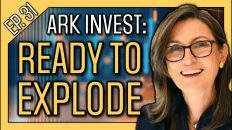Mentioned in Video:
- Inflation, Interest Rates, Russia-Ukraine, Innovation Solving Problems | ITK with Cathie Wood ▶ https://www.youtube.com/watch?v=sr2PmvZ6buQ
- CNN Fear and Greed Index ▶ https://money.cnn.com/data/fear-and-greed/
- 10-Year Treasury Minus 2-Year Treasury Constant Maturity ▶ https://fred.stlouisfed.org/series/T10Y2Y
- UM Surveys of Consumers ▶ https://data.sca.isr.umich.edu/charts.php
- Federal Open Market Committee (FOMC) Monetary Policy Meetings – https://www.federalreserve.gov/monetarypolicy.htm
- 12-month percentage change, Consumer Price Index, selected categories: https://www.bls.gov/charts/consumer-price-index/consumer-price-index-by-category-line-chart.htm
- FRED Economic Data – Total Vehicle Sales: https://fred.stlouisfed.org/series/TOTALSA
- Support the channel and get extra member-only benefits by joining us on Patreon: https://www.patreon.com/tickersymbolyou
💥 In the Know with #CathieWood is a monthly #ARKInvest series that talks about #stocks, #macroeconomics, and #technology. Here's a 10-minute supercut of ARK Invest's latest episode, where Cathie Wood talks about the impacts of the Russia-Ukraine conflict on the markets and different indicators we can be watching now. Sources are provided for investors to come to their own conclusions.
Video Transcript:
0:00
cathie wood just released the latest
0:01
episode of in the know her monthly video
0:03
series where she talks about advanced
0:05
technologies stocks and the broader
0:07
markets she offered a ton of great
0:09
insights around how the war between
0:10
russia and ukraine affects people and
0:12
markets across the world from stocks and
0:15
bonds to commodities and even
0:16
cryptocurrencies i think that keeping up
0:18
with the big picture of the markets this
0:20
way is really valuable for investors and
0:22
i recommend watching the whole episode
0:24
i've linked it in the description below
0:26
if you're short on time though i've
0:27
created a super cut of the highlights
0:29
and added the right charts and sources
0:31
for context timestamps are enabled if
0:33
you want to skip to a specific topic and
0:35
stick around to the end where i'll share
0:37
my quick take on what i think is going
0:38
on and also show you two easy metrics
0:40
that you can track for yourself your
0:42
time is valuable so let's get right into
0:45
it starting with the super cut of kathy
0:47
wood's latest in the know after a shock
0:50
the trends that were in motion tend to
0:53
come back into motion and 9 11 2001
0:58
we were in recession before that was the
1:01
tekken telecom bust and uh the shock
1:04
made everything a little bit worse a
1:06
little rebound and then back into
1:08
that recession and as you know that was
1:11
a right call for for covid well in the
1:14
last year
1:16
this fear of inflation and interest
1:18
rates moving up and destroying uh the
1:22
valuations in the marketplace have have
1:25
gripped the markets it seems as though
1:27
the algorithms were focused primarily on
1:30
high valuation stocks in our strategies
1:33
we own what looked like very high
1:36
valuation stocks in
1:38
in the short term if you're only looking
1:40
at this year
1:42
and i do realize that investment time
1:44
horizons shrink during times of turmoil
1:47
we now believe
1:49
that
1:50
russia and ukraine have turbocharged
1:53
that shock
1:54
and actually hopefully moved it in into
1:57
a period that is very cathartic and
2:00
helps people understand that what's
2:02
going on right now from our point of
2:04
view at least
2:05
is that
2:07
the higher interest rates and higher
2:09
inflation are acting like taxes on the
2:13
system and we've been talking for a
2:15
while about this about
2:17
consumption slowing down dramatically if
2:19
you look at retail sales and i'm talking
2:21
about real retail sales take out the
2:23
inflation
2:24
and
2:25
real consumption
2:27
we've seen a dramatic slowdown since
2:30
since october
2:32
and we are beginning to see inventories
2:34
pile up all of that is working out the
2:37
way we expected it to our surprise is
2:40
that many economists and strategists out
2:42
there aren't putting two and two
2:44
together
2:45
so now let's turn to monetary policy
2:48
chairman powell said the fed would raise
2:51
interest rates he also did say when
2:53
asked the question
2:54
that he would get aggressive if
2:57
inflation seemed to be
2:59
embedding into the system we are not
3:02
expecting that why
3:04
it comes back to this concept of
3:06
velocity
3:07
the rate at which money turns over so
3:10
from the fourth quarter of 64 to the
3:12
first quarter of 81 velocity increased
3:15
21
3:17
and what that meant at that time at
3:19
least is many people as soon as they um
3:23
got more income they would buy goods and
3:25
services and especially goods right away
3:28
as quickly as possible because they were
3:30
afraid prices would go up or interest
3:33
rates in the case of cars and other
3:35
durable goods would go up so buy now
3:37
before prices and interest rates go up
3:39
from the third quarter of 97 to uh the
3:43
fourth quarter of 2021 velocity has
3:48
dropped 50 percent
3:50
and consumer sentiment would suggest
3:53
that it the next leg in velocity will be
3:56
down one of the metrics we keep our eye
3:59
on is energy consumption as a share of
4:02
gdp that is reaching a high that we have
4:06
not seen since 0809 every time it has
4:09
reached that level we
4:11
we have gone into recession i noticed
4:13
today the white house is proposing a ban
4:16
on russian imports um i think that
4:19
russian imports account for roughly
4:22
three percent of our energy imports so
4:25
that's not devastating
4:27
but it will it will cause
4:29
again more problems and it is why one of
4:33
the reasons prices are going up we also
4:35
know as i mentioned before that real
4:37
retail sales and real consumption if you
4:40
average out the fluctuations over the
4:42
last three months look pretty flat if
4:44
not slightly down meanwhile inventories
4:48
are picking up pretty at a pretty rapid
4:50
rate inventory to sales ratios many
4:53
people point out are very low but if
4:55
consumption stops inventories can build
4:58
very quickly and
5:00
then our supply chain problems will go
5:02
away not the best way for that to happen
5:04
but it but it is true energy is the only
5:07
sector that's up it's up 33 percent
5:10
uh the worst performing sectors uh are
5:13
associated with the consumer again um i
5:16
think the loss of purchasing power is a
5:19
big problem for the consumer now that
5:21
the fear is that the fed is going to
5:23
increase a number of times
5:26
we're seeing short-term interest rates
5:29
up a lot
5:30
certainly
5:31
in the context of recent history but
5:34
long rates not going up as much and so
5:36
the yield curve has compressed to 25
5:39
basis points
5:41
now uh
5:42
we're getting close to an inverted yield
5:45
curve meaning meaning long rates
5:48
uh below short rates and that is often a
5:51
sign that the fed is too tight
5:54
and uh real growth is going to
5:56
disappoint and inflation
5:59
is going to be lower than expected uh we
6:02
think that is the case and we've thought
6:04
so for some time
6:06
commodities they're on fire we believe
6:09
this is a supply problem much more than
6:12
a demand problem i'm sure there's a
6:13
scramble to build inventories of
6:16
anything now anything in the energy
6:17
complex
6:19
any of the metals that come out of
6:21
russia
6:23
food out of the bread basket of the
6:25
ukraine
6:26
interestingly the commodity price
6:28
increases are in the face of the dollar
6:31
increasing
6:32
the dollar
6:33
increasing tends to put pressure on
6:36
prices uh but this un the supply problem
6:40
and maybe inventory hoarding is
6:42
overcoming that the dollar is going up
6:45
because it's a it's a flight to safety
6:49
currency
6:50
and we're also seeing other flights to
6:53
safety so the dollar is up about two and
6:55
a half percent since the end of january
6:58
uh and then the other two flights to
7:00
safety we've seen bitcoin 6.1 percent
7:04
and gold 8.3
7:06
we're seeing donations of both bitcoin
7:08
and ether to the ukraine i think it's 50
7:11
million if i'm not mistaken in the last
7:14
week and we're also seeing bitcoin as a
7:17
currency hedge for russian citizens
7:20
who
7:20
are watching the ruble um get uh
7:23
hammered here
7:24
tesla is providing free supercharging in
7:28
poland uh
7:30
poland's taking in of course a lot of
7:32
refugees
7:33
and of course we know that longer term
7:37
electric vehicles are going to help um
7:41
with the demand destruction of oil
7:44
i think the prices alone will destroy
7:47
a lot of demand for oil and accelerate
7:51
the shift to
7:52
electric vehicles and especially
7:55
we believe robo taxis will be electric
7:58
and they'll be on the road 50 to 60
8:00
percent of the day so that acceleration
8:02
away from oil will happen as we move
8:05
into
8:06
into the autonomous realm we're seeing
8:09
of course the social platforms providing
8:12
real real-time updates and providing you
8:15
know a glimpse into the horrors that are
8:18
taking place there and i think that has
8:21
put a lot of pressure on
8:24
financial institutions and others uh to
8:28
boycott uh or stop doing business with
8:31
russia it's terrible for the the russian
8:33
citizens who do not want this invasion
8:36
uh but uh i think we've never seen
8:39
the financial system used as such a
8:42
weapon
8:43
and we'll see we'll see if it works the
8:46
president of ukraine
8:48
reached out to elon musk and say hey
8:51
we're being cut off out out there and of
8:53
course
8:54
elon sent
8:55
starlink to the rescue that's phenomenal
8:59
that's phenomenal that
9:01
we can continue to
9:03
communicate with these people and again
9:07
everyone around the world can see the
9:09
horror uh that uh that ukraine is
9:12
experiencing
9:14
those are those are a few i mean there
9:16
are many other on the medical front uh
9:19
there's a company called butterfly
9:22
which has sent hundreds if not thousands
9:24
of point-of-care ultrasounds for medical
9:27
triage and emergency uh response
9:30
and
9:31
there's a company called 908 devices
9:34
which is the only mobile mass spec
9:37
uh machine broadly uh that that enables
9:41
uh in the field detection of hazards bio
9:44
weapons pollutants
9:46
uh and uh contaminants so
9:49
the private markets uh
9:51
certainly appreciate what innovation can
9:53
do and will do
9:55
to help solve the problems that have
9:58
have
9:59
arisen from the coronavirus crisis
10:02
the supply chain problems now uh russia
10:05
and and the ukraine so the big theme of
10:08
the episode this month is that the
10:10
market is getting things backwards
10:12
inventories are piling up not because
10:14
supply chain issues are getting fixed
10:16
but because demand is down and the
10:17
consumer has less purchasing power
10:19
commodity prices are on fire again not
10:22
because of demand but because of lack of
10:24
consistent supply the fed is raising
10:26
interest rates to slow down systemic
10:28
inflation but inflation is being driven
10:30
by very specific catalysts that won't
10:33
always be around don't get me wrong
10:35
inflation in certain areas is very real
10:37
but as kathy wood pointed out if it was
10:40
persistent and widespread people would
10:42
be spending more money faster simply out
10:44
of fear that it would be worth even less
10:46
in the future but that's not what's been
10:48
happening and as a result the worst
10:50
performing market sectors have been the
10:52
ones associated with the consumer
10:54
worrying about inflation and demand when
10:56
supplies are the issue leads to bad
10:58
outcomes for example the fed possibly
11:01
over correcting with interest rates
11:03
again if everyone was able and willing
11:05
to spend money inventories wouldn't be
11:07
piling up and money would be moving
11:09
faster when it comes to the effects of
11:11
these things on growth stocks i think
11:12
there are two very easy metrics that
11:14
will instantly make you a more informed
11:16
investor let me walk you through them
11:18
the first is the 10-year treasury bond
11:20
yield minus the two-year bond yields are
11:22
a function of their price if demand for
11:24
a bond goes up is price goes up which
11:26
means its yield goes down assuming the
11:29
economy is stable longer term bonds
11:31
should yield more than shorter term
11:33
bonds so a bigger difference between the
11:34
two year and the 10 year means that more
11:37
near-term economic growth is being
11:39
priced into the market more growth means
11:41
more inflation which tends to lead to
11:43
higher interest rates as we're seeing
11:44
play out right now when the difference
11:46
between the 10-year and the two-year
11:48
approach is zero as it has in the past
11:50
it implies economic uncertainty and that
11:53
this kind of high economic growth period
11:55
might be about to end during this time
11:57
demand for bonds of all durations are
11:59
roughly the same so their difference is
12:01
zero which implies that people aren't
12:03
sure what kind of investments they
12:05
should be making long term short term or
12:08
something in between and if the two-year
12:10
bond starts yielding more than the
12:11
10-year which doesn't happen very often
12:13
it means that the demand for the 10-year
12:15
bond is higher and people are fleeing
12:17
towards long-term safety so this chart
12:19
shows that less and less economic growth
12:21
is getting priced into the market right
12:23
now which means that sentiment should be
12:25
way down this is a good one to bookmark
12:27
and i'll leave it for you in the
12:28
description below let's confirm this
12:30
with the other metric i think you should
12:31
really be tracking which is cnn's fear
12:34
and greed index the fear and greed index
12:36
looks at how fearful or greedy people in
12:38
the market are being but instead of
12:39
using bond yields it combines a few
12:41
different looks at stocks and bonds as
12:43
of friday's close we're in extreme fear
12:45
territory and that's for a few different
12:47
reasons over the last couple months
12:49
there have been more and more stocks
12:51
hitting yearly lows relative to those
12:53
hitting yearly highs that number is now
12:55
still moving sideways we really want to
12:57
see this trend reverse and stay stable
13:00
not choppy speaking of choppy the market
13:02
is very choppy right now the vix is the
13:05
volatility index of the s p 500 and
13:07
normal market volatility is anywhere
13:09
between 12 and 20. the vix staying up
13:12
around 30 means that the market is
13:14
behaving very erratically as a result
13:16
bonds have outperformed stocks by over 4
13:18
percent during the last 20 trading days
13:21
this is some of the weakest performance
13:22
of stocks relative to bonds over the
13:24
last two years indicating that investors
13:26
are fleeing away from stocks toward the
13:29
safety of bonds and of course the s p
13:31
500 itself is around five percent below
13:34
its 125 day moving average and it's
13:37
moved there pretty fast sharp declines
13:39
in such a broad index indicate pretty
13:41
widespread fear in the markets this is
13:42
why we've been bouncing around between
13:44
fear and extreme fear over the last two
13:47
months if you're trying to be greedy
13:48
when others are fearful and fearful when
13:50
others are greedy now you at least know
13:52
what everyone else is doing in my
13:54
opinion kathy what is right about the
13:56
russia ukraine conflict causing a shock
13:58
in the market for growth stocks and
14:00
driving them to new one-year lows and we
14:02
can see that in the most recent leg down
14:04
from fear to extreme fear so even if you
14:07
don't have time to keep up with every
14:08
single news item swaying the market one
14:10
way or the other this fear and greed
14:12
index is a great way to keep up with how
14:14
everything together is getting priced in
14:16
and remember just because the market is
14:18
showing extreme fear right now doesn't
14:20
mean that it can't go lower like it did
14:22
in march of 2020 so what i'm looking for
14:25
now is for the difference between the
14:27
10-year bond yield and the two-year
14:28
yield to start trending in the other
14:30
direction as well as a steady and
14:32
consistent reversal in this fear and
14:34
greed index in my opinion if the fed
14:36
really watched these kinds of indicators
14:38
they wouldn't be so quick to sharply
14:40
raise interest rates comment below with
14:42
your thoughts on these kinds of
14:43
indicators do you find these super cuts
14:45
and resources helpful do you think that
14:46
cathy wood is right about this russia
14:48
ukraine conflict shocking and already
14:50
weak market for growth socks or do you
14:52
think that there's something else going
14:54
on entirely i read all my comments and
14:56
i'm excited to hear your thoughts if you
14:58
want to keep up with my real-time
14:59
thoughts on this continued market
15:00
downturn feel free to follow me on
15:02
twitter instagram and tick tock yes even
15:05
tick tock i share smaller tidbits and
15:07
insights on those platforms whenever i
15:09
find something new and if you want to
15:11
know what i'm buying and buying for
15:13
myself check out this video right here
15:15
next either way stay long stay strong
15:18
and thanks for watching until next time
15:20
this is ticker symbol u my name is alex
15:22
reminding you that the best investment
15:24
you can make is in you
If you want to comment on this, please do so on the YouTube Video Here














